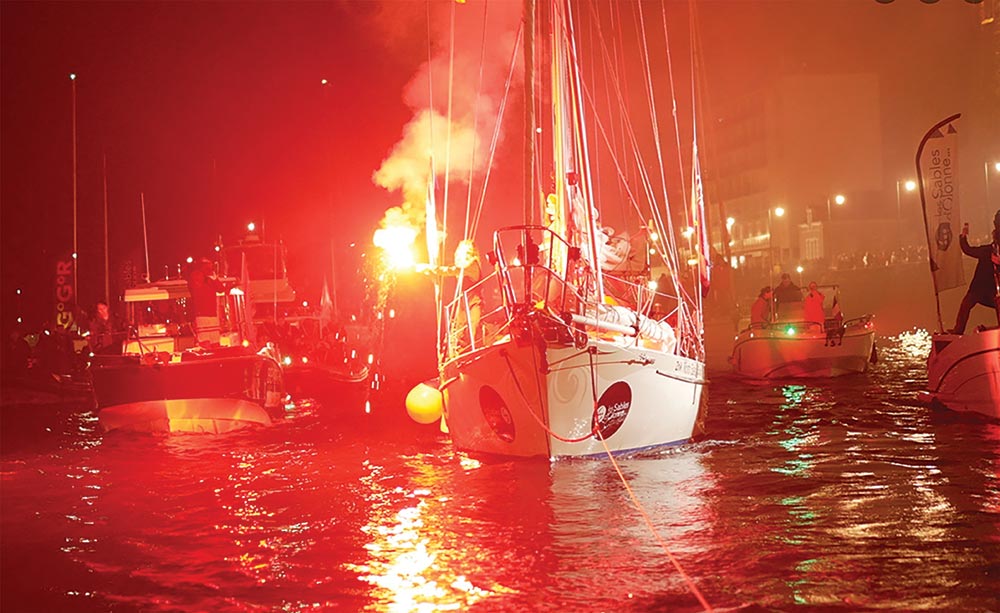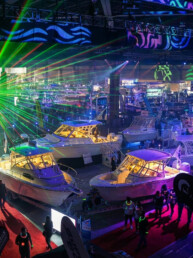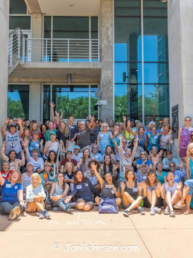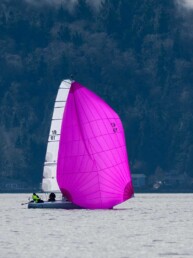
Last month, 48° North had the privilege to sit down with the first woman to win a solo round-the-world race, South African sailor Kirsten Neuschäfer. Kirsten won the “retro” Golden Globe Race (GGR) in 2023, a non-stop circumnavigation using smaller boats and technology that was available during the original GGR in 1968—no GPS, nor modern weather info or communication. In the first portion of the interview (published in the April issue of 48° North), we learned lots about her background, her vast offshore experience, her comfort with traditional maritime skills, and her Port Townsend built Cape George 36 Minnehaha. As in part one, joining in the conversation was two-time Race to Alaska winning skipper, Jeanne Goussev. In this month’s half of the interview, we hear more details about Kirsten’s victorious non-stop circumnavigation during the GGR.
Joe: Tell us about your approach to getting rest?
Kirsten: Fortunately, one of the concessions they had to the 1968 technology was that we could have an AIS alarm; it didn’t give you a display and a ship’s name and position like you’d get with a modern system, but it would warn you that there was a ship in the vicinity. It was nice having that alarm, because at least you could get rest without fearing the whole time that you were going to get run down by a ship. But then, of course, it didn’t always help in foggy conditions—the alarm would go off, but you couldn’t see anything, and you couldn’t talk to it because ships aren’t used to being called “Big ship, big ship,” they’re used to their name being used.
If I was in a shipping area and I was tired, I’d set an alarm so I wouldn’t sleep for too long. Otherwise, I pretty much took the rhythm of naturally waking up every one to two hours to do a logbook entry so that I’d have my course—my boat’s heading and speed—to do my dead reckoning. Otherwise, it depended mainly on where I was, like in the trade winds where the winds are pretty settled, I’d get better rest than if I was somewhere the winds were shifting all around.
How different is this rhythm than what you’ve found on other offshore passages?
The majority of the trips I’ve done were with crew, so that changes because someone is always on watch, and there’s a fixed watch roster. When you’re off watch, you can sleep deeply, because if you’re needed, you’ll be called. On your own, you don’t sleep that deeply because you don’t want to miss something. I got into a sleep pattern where I’d very easily wake up, but I’d also very easily go back to sleep again. If the boat’s motion changed because the wind had changed, and the self steering was putting us on a new course—I’d feel the difference in the motion. Or, if there was a funny noise or something like that, I’d naturally get up. But I could get up, do my check or whatever I needed to do to the sails, and then go back to sleep again.
The other difference, of course, was that it was a race, so I was pushing myself harder. I was forcing myself to be more proactive to tweak more speed out of the boat. It was really helpful to do the two long trips beforehand (editor’s note: in Part One, we learned that Kirsten sailed 15,000 solo ocean miles on Minnehaha before even starting the GGR). They weren’t racing trips, but they were training. So I was able to take much of it in stride. There were only very few occasions I felt seriously fatigued. One of those occasions was right at the start because of all the build up and all the public stuff going on. It was actually a great relief to get out to sea because I could finally get some rest!
Any ocean passage is going to involve some heavy air or storm sailing, tell us about your experience with that on this race. What techniques did you employ?
One of my storm tactics on a monohull has always just been to heave-to. And I didn’t necessarily use that each time on Minnehaha on the race, because if the storm is coming from behind and you can use some of its energy to keep moving, it would be better than grinding to a halt by heaving-to. If I had a storm that was coming up from behind, my tactic was to trail warps behind the boat. That worked really well in conjunction with the Hydrovane, because she could really keep her stern to the seas, but she’d keep her speed up at maybe 4 to 5 knots in those conditions. I felt that she was well under control, but what wasn’t that great about that storm tactic is that you get breaking waves coming over the stern and there’s a risk that some damage gets done to the stern, like the vane or other mountings on the stern. I had relatively minor damage, but on a whole, I felt the boat was safe. That was important.
If the wind was against me, for example off of the Falkland Islands, my tactic was to heave-to and Minnehaha did that incredibly well. It was way more comfortable, there weren’t problems with damage or things getting broken or the cockpit filling up. My only concern there was slipping sideways down a wave and then the Hydrovane coming to some grief. That was trial and error—I didn’t disengage it because then it swings too freely, but I also didn’t lash it tight because there’d be no give if it did slip down a wave. So I had it set with the vane pointed to windward, so if the waves did put a lot of pressure on the rudder, the vane would move, but it wasn’t swinging wildly.
Jeanne: Were there times that hand steering was better than using the Hydrovane?
In storms, I didn’t find it helped, because when going slow downwind I didn’t find that I could keep a better course than the Hydrovane. With the spinnaker or really surfing waves, then hand steering was better. But in the storm conditions, we weren’t doing crazy speeds, and that’s what I was trying to stop—having to do those crazy speeds and sit in the cockpit, then there’s a good chance of the boat maybe capsizing or you getting washed over. The best survival tactic seemed to be to set up everything so the boat can keep control of itself and you can stay down below and out of harm’s way.
Joe: Of those stormy experiences you had on the race, does any loom largest in your memory?
No, my first proper sail on Minnehaha was basically into a 50-knot storm. After that, everything seemed like, “Eh, it’s alright, we’ve been through this already.”
One of the storms during the race, they did warn us. I could hear from the New Zealand forecast that there was a very big system coming up behind. It’s often the anticipation that’s worse than the actual storm. I did my best to go as far north as I possibly could. In that moment, I didn’t ever have to think, well should I stop going north and cut the corner and make sure I’m ahead of the other competitors. In that moment, it was like, “All that matters is to let the storm pass without breakage.”
What did pushing your boat, which most would not consider a performance boat, and pushing yourself mean to you?
For example, in the trade winds during a squally night, if I was not racing I would be inclined to drop the spinnaker. Even with crew, I might say let’s just get rid of the spinnaker and not risk that kind of breakage. But in a race, it’s not like that. When squalls are around, you’re going to have to be on your toes, because you’ve got the spinnaker up as much as you can for as long as you can. It was actually a great joy, because it was the first time in my sailing life that I could sail for the sake of sailing, where I didn’t have to think the whole time about not damaging anything. I didn’t want to damage anything, but the spinnaker was there to be used, it wasn’t there to hand over to an owner with his new boat. So in that sense, I did push harder. That also went for how soon I would reef. If I thought I was going to go faster because the boat was going to be heeling less, then I’d reef sooner, but otherwise, I’d definitely wait longer to reef; I’d wait way longer to drop the spinnaker. I’d sometimes sail where I was really on the edge and I’d think to myself, “This is actually not how I should be sailing right now, but we’re getting good speed and it still feels stable, so let’s keep going!”
Did you find yourself on the other side of that edge?
Yeah, I had a few broaches with spinnakers. I had a few moments where I saw a squall but asked myself, “But is it going to be a bad squall?” And I didn’t take the spinnaker down and then regretted it when dropping the spinnaker in sub-optimal conditions. Definitely in the Southern Ocean with that twin rig, I was pushing the boat way harder than I should have been. Nothing happened, there were no broaches or anything funny, but it was one of those moments when I said, “If something happens, there’s going to be bad breakage.”
Jeanne: It’s an interesting balance, on a 235 day race, to strike between preservation and speed.
Yeah, that’s what breaks it for some people—they just push too hard. For such a long race like this, my previous more conservative approach to sailing that was all about preserving the a delivery boat or a charter boat might have stood me in good stead. Maybe I pulled the plug a little earlier than a real hard racing sailor might.
Joe: Aside from the win itself, one of the great stories from your race is when you rescued fellow competitor Tapio Lehtinen, whose Gaia 36 sank. Can you share that story with us?
Well, I heard a competitor was in distress because we were all informed by the race organizers, and I knew I was probably the closest to him. After I confirmed that by contacting the race organizers, in that moment, the only thing I wanted to do was help. You’d feel like an idiot if you won the race but you left your fellow distressed competitor behind, you know?
There were a few things that struck me about the rescue. One is just how difficult it was to see a life raft on a big rolling ocean, even though the conditions weren’t extreme by any means. The other interesting thing for me was how positive Tapio was. He was full of jokes and laughter, and to me that was a lesson in life. If I’m feeling down because things aren’t going my way, I just just have to think of poor Tapio—he lost his boat and still kept a good sense of humor about it.
The other thing that was interesting was the actual transfer of him onto the ship. Because it isn’t something you practice in your daily life as a sailor. That was the most adrenaline for me—getting as close as I could to the ship and feeling like, “This is crazy, I shouldn’t be anywhere near this big ship in the middle of the ocean.” It helped that the ship formed a lee. The captain was cool because he really did park it up square to the waves. But still, in your mind you’ve been trained to stay the hell away from big ships at sea.
What was one piece of gear or boat equipment that you found to be the most essential to your race?
The self steering. On a race like that that’s so long, and you’re on your own, it’s really important. Without it, you’d get a lot less rest and you’d sail a lot less efficiently.
Thinking about the history of the original GGR with three very famous sailors and their stories—Knox-Johnson being the first sailor to win a non-stop round the world race, Moitessier bailing on the race to go around again, Crowhurst’s tragic unraveling—we have a sense about the relationship each of those sailors had with the sea. As a GGR winner, I’m curious about how your relationship with the sea evolved during your 235 days, or did it?
I don’t know if it changed. It might have deepened, because I feel a deep sense of gratitude that the sea allowed me to sail right around the globe without coming to grief. I’ve always loved the sea, I like being outdoors, I like being in nature, I like being on the ocean—and all of those things were affirmed on this race. I didn’t want to be out there most looking forward to the end of the race, like I heard one of the other competitors say at one point. The thing I was most looking forward to was being out there, seeing the boat really perform, and enjoying the ocean.
I had a lot of moments when I was so in my groove, in my own little bubble, so enjoying myself that I was like, “I must be one of the luckiest people on the planet, because my whole purpose today and every other day that I’m on the race is to get up, enjoy myself, look after the boat, and make the boat sail the best I possibly can.” And then there were other moments when I would try to just chill out a little bit. It’s not only about racing the whole time. It’s about appreciating the privilege to be in a very beautiful, very pristine environment that not everyone can access. I still miss being disconnected and just with the ocean.

Jeanne: I like to go to sea because it offers the opportunity to catch my breath in a lot of ways I can’t on land. Were there moments out there that made you just pause and catch your breath and be in awe?
Yeah, those were moments when I didn’t know if I wanted this to end. The double blessing of the Golden Globe Race was not having modern technology. That’s one of the things I’ve always enjoyed about being at sea—you can switch your phone off and pack it away because you’re not going to get a signal out there. The sat phone is more tedious, so if you must communicate, you can, but it’s not that constant connectivity. I wouldn’t want to go to sea with Starlink, for example. That would spoil some of it for me. I felt more refreshed when I stepped off the boat at the end of the race than I had for a long time. It allows you to appreciate that a lot of the things you’re worrying about in land life are pretty abstract. They’re not real problems that you have to solve.
Joe: Lightning round — describe a situation on the race when you felt the following emotions:
Joy: One of my most joyous moments was in the Southern Ocean in 50-plus knots of wind, with really big, smooth, regular, long-period swell. Minnehaha was just surfing at crazy speeds—speeds she probably shouldn’t have been sailing at, I didn’t have a GPS, but judging by the wake and the rooster tail she was shooting, I would guess maybe 12 or 14 knots—and I was feeling a bit of adrenaline, but also joy. I thought, “This is cool, this is great sailing.” The sun was out and it was crisp, clear air, and the sea was full of energy but in a kind way as opposed to a storm that wants to damage you all the time.
Fear: I didn’t have any real fear moments where I feared for my life. I definitely had moments of anxiety when there was a storm approaching, like 900 miles away from Cape Horn where it was more the anticipation of the storm that was forecast to be a big one. I was thinking, “Let’s hope this goes well.”
Relief: I was very relieved when the wind filled in after sitting for two weeks in the doldrums. Two weeks was too much, and it was a weight off my heart when the boat finally started moving because the wind came back.
Peace: I had a lot of peaceful moments. I felt pretty at peace with myself when I got around the Horn. That’s the thing you want to get past, because once you’ve passed it, you’re on the run home and you’re getting away from the stormier latitudes.
If you could relive any single day from the race, what would it be and why?
One of the days I’d love to relive is the 24 hours that I was bobbing around Cape Town, becalmed. There was so much wildlife around me—humpback whales right next to the boat. At the time, I don’t think I appreciated that as much as I should have, I was frustrated because I wanted to move. It was very special, but if I relived it, I would think, “Thank goodness there’s no wind right now, because if there was, I wouldn’t be seeing what I am.” I might even go for a swim or something.
If you could be transported to be sailing anywhere in the world right now, where would you go?
The Northwest Passage. When the time comes, if I could do that, that would be really cool.
You’re a hero to lots of people. If someone wants to follow in your footsteps, what’s one piece of advice you’d give them?
Take people’s advice and value it, but it’s still your project. Do it your way. You don’t have to copy someone else, even if you’re doing a trip that’s already been done. It’s going to be your journey.
Jeanne: The GGR is an adventure race. You’ve done a lot of adventuring and long journeys of self discovery. So why adventure?
It’s the thing that enthuses me most in life. It’s the one thing that makes me feel really happy and alive. It’s my thing. I feel more alive doing adventures than sitting around and doing adventures of the mind. But for me, I like to be out there in the physical world. It brings me closest to nature.
Joe Cline is the Managing Editor of 48° North.
Joe Cline
Joe Cline has been the Managing Editor of 48° North since 2014. From his career to his volunteer leadership in the marine industry, from racing sailboats large and small to his discovery of Pacific Northwest cruising —Joe is as sail-smitten as they come. Joe and his wife, Kaylin, have welcomed a couple of beautiful kiddos in the last few years, and he is enjoying fatherhood while still finding time to make a little music and even occasionally go sailing.






